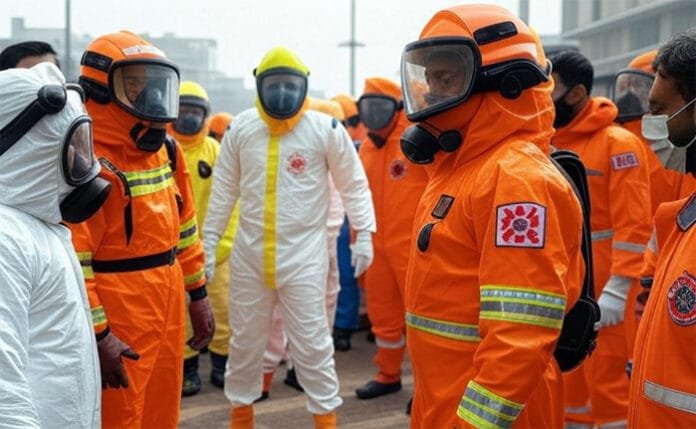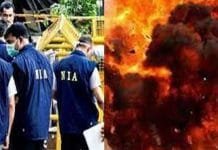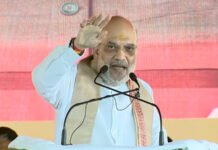INVC NEWS New Delhi — On May 7, 2025, the Ministry of Home Affairs (MHA) will conduct nationwide mock drills as part of its proactive strategy to strengthen disaster preparedness and emergency response mechanisms across all states and union territories. This high-priority exercise aligns with India’s growing focus on national security, civil defense, and disaster risk mitigation, especially in the face of rising threats from natural calamities, terror incidents, and industrial accidents.
Objective of the May 7 Nationwide Mock Drill
The MHA has issued a comprehensive directive under the National Disaster Management Authority (NDMA) to ensure states are fully equipped to deal with multi-hazard emergencies. These include scenarios like:
Earthquakes
Floods and Cyclones
CBRN (Chemical, Biological, Radiological, Nuclear) threats
Terrorist attacks
Urban fires and industrial hazards
The primary goal is to test coordination, evaluate response time, and refine the execution of emergency protocols involving district administrations, police, fire services, medical teams, and civil society stakeholders.
Mandatory Guidelines for State and District Authorities
To ensure uniformity and effectiveness, the MHA has laid out strict compliance guidelines for state-level disaster management authorities. These include:
1. Pre-Drill Preparations
Selection of Vulnerable Sites: District collectors must identify high-risk zones—industrial areas, schools, public transport hubs, and hospitals—as epicenters for the mock drills.
Notification to Citizens: Advance alerts must be issued via local media, WhatsApp groups, and public announcement systems to prevent panic.
Stakeholder Briefing: All participating departments—including health, police, education, transport, and municipal bodies—must be thoroughly briefed.
2. Execution Day Protocols
Activation of Emergency Systems: Real-time simulation of earthquake tremors, fire outbreaks, or CBRN leaks must be carried out using sirens, alarms, and public broadcast messages.
Deployment of Rescue Forces: NDRF (National Disaster Response Force) units, local Home Guards, and Rapid Action Teams must be mobilized.
Medical Response Simulation: Setup of triage zones, mock ambulance dispatch, and hospital evacuation procedures is mandatory.
Traffic Management: Law enforcement must cordon off the area and create green corridors for emergency vehicles.
3. Post-Drill Assessment
Independent Evaluation Committees must assess the execution based on response time, inter-agency coordination, and citizen cooperation.
States must submit detailed reports to the NDMA within 48 hours, highlighting successes, failures, and recommendations for improvement.
States Directed to Prioritize High-Risk Regions
The MHA has instructed all states to prioritize regions that are historically disaster-prone. For instance:
Assam, Himachal Pradesh, Uttarakhand – earthquake simulation zones
Odisha, West Bengal, Andhra Pradesh – cyclone and flood management exercises
Maharashtra, Delhi, Gujarat – urban fire and CBRN threat responses
Jammu and Kashmir, Punjab, Rajasthan – counter-terror preparedness drills
Public Participation and Awareness Drive
An essential aspect of the drill is community awareness and preparedness. The NDMA has urged states to:
Distribute safety manuals to households and schools
Conduct mock evacuations in residential complexes
Organize workshops and safety lectures in educational institutions
Promote use of the ‘Aapda Mitra’ mobile app for real-time alerts and first-response guides
The idea is to build a culture of self-reliance in emergencies, especially in urban zones with dense populations.
Integration with Smart City Infrastructure
The drills are also a testbed for smart city command centers. Cities like Hyderabad, Bengaluru, Lucknow, and Ahmedabad will integrate:
CCTV surveillance feeds
GIS-based disaster tracking
Real-time mobile alerts
Drone-assisted aerial reconnaissance
This multi-modal response is aimed at ensuring zero-delay coordination between departments using technology-enabled disaster dashboards.
Focus on Vulnerable Institutions: Schools, Hospitals, and Metro Networks
The MHA directive puts a special emphasis on critical institutions such as:
Schools and colleges – Mandatory mock fire evacuations and anti-earthquake drills for students and staff
Hospitals – Training on mass casualty handling, triage setup, and backup power protocols
Metro rail and public transport systems – Simulations of blast scenarios, fire evacuations, and CBRN contamination response
These facilities must maintain video records of the drills and submit compliance reports to State Disaster Management Authorities (SDMAs).
CBRN Threat Response: A Rising Priority
Given the global uptick in CBRN-related threats, mock drills will include:
Chemical leak simulations in industrial zones
Biological hazard response in public hospitals
Radiological emergency protocols in nuclear research centers
Nuclear fallout drills near sensitive military installations
Hazmat suits, decontamination chambers, and CBRN command units are to be tested for readiness.
Evaluation by Central Observers
A team of central observers from MHA and NDMA will be stationed across select cities to assess implementation quality. Their criteria will include:
Inter-agency synergy
Real-time decision-making
Civilian participation
Communication systems effectiveness
Response and recovery timelines
Based on these evaluations, the top-performing states and districts may be recognized with national honors at the Annual Disaster Management Summit.
Final Reporting and Policy Integration
Post-drill, all state and district authorities are to submit:
Incident response summaries
Photographic and video documentation
Citizen feedback reports
Corrective action plans
These reports will be compiled by the NDMA to refine Standard Operating Procedures (SOPs), which will be integrated into the National Disaster Response Framework (NDRF).
Building a Resilient India
The May 7 nationwide mock drills underscore India’s resolve to evolve into a disaster-resilient nation. By enforcing uniform preparedness protocols, engaging civil society, and harnessing smart technologies, the MHA is laying the foundation for a stronger, faster, and unified response mechanism across the country.
Every state, district, and citizen has a role to play. These drills are not mere formalities—they are a national rehearsal for survival, resilience, and coordinated recovery.















